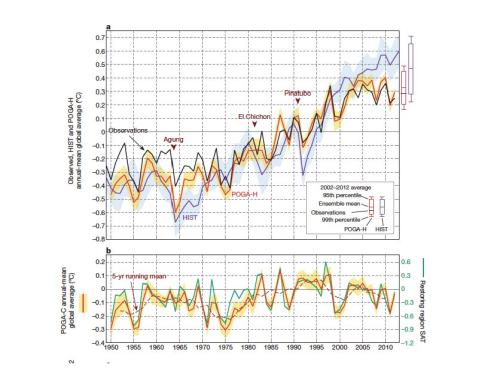Poor Tony, yet something else pointing out the folly of his and other’s thinking. And crazy Bob Catter must be pulling out his toenails by now.
>>A slowing in global warming that climate sceptics say undermines the greenhouse theory is simply a “hiatus” from higher temperatures, according to scientists.
Scientists say it could be explained by naturally occurring La Nina weather events in the Pacific Ocean in recent years.
La Nina brings cooler waters to the surface and potentially masks the global heat-trapping effect of rising emissions of greenhouse gases.
“The current hiatus is part of natural climate variability, tied specifically to a La Nina-like decadal cooling,” according a University of California study.
University of NSW’s Alex Sen Gupta said the new study of the Pacific was “compelling evidence” that warming was being masked by the oceans and that the slowdown was tied to natural cycles.
Past studies have linked the slowdown in the pace of warming to factors such as a build-up of sun-dimming air pollution in the atmosphere or a decline in the sun’s output. Others suggest that the deep oceans may be absorbing more heat.
Some experts noted the study did not fully explain the hiatus.
“An important question that the paper does not address is where this energy has gone. Almost certainly it is in the deep ocean,” Will Hobbs, of Australia’s Institute for Marine and Antarctic Studies said.
Sceptics have seized on the discrepancy as proof that if warming exists, it is not man-made but has natural causes such as fluctuations in solar heat.
A UN panel of scientists will issue a report in late September but drafts show it is likely to raise the probability that human activities are the main cause of climate change to “extremely likely”, or a 95 per cent chance. That is up from 90 per cent in the last report in 2007.
The current hiatus is part of natural climate variability, tied specifically to a La Nina-like decadal cooling.
University of California study.
Its main scenarios also show that temperatures could rise by up to about 5 degrees celsius by 2100.
However, the drafts devote little space to explaining the hiatus in rising temperatures.
Almost 200 governments have agreed to limit a rise in temperatures to less than 2 degrees celsius above levels before the Industrial Revolution.
That means the average world surface temperatures should not rise above about 15.6 celsius.
Temperatures have so far gained by about 0.8 degrees celsius and many scientists say that warming is already causing more extreme weather, ranging from heatwaves to downpours.
Nine of the 10 warmest years since records began in the mid-19th century have been since 2000, with 1998 the exception, according to the UN World Meteorological Organisation (WMO).
Even so, the pace of warming has slowed from the 1980s and 1990s even though greenhouse gas emissions have hit record highs.
There have been four years with La Nina cooling events in the Pacific since 1998 and only two with the opposite, El Nino, when the Pacific waters warm, according to WMO data.<<
http://www.abc.net.au/news/2013-08-29/slowdown-in-global-warming-only-temporary/4920476
